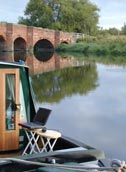Graham Klyne


http://www.ninebynine.org/
![]()
Mastodon: @gklyne@indieweb.social





| Work | Leisure | Pictures | Software | Links | NineByNine.net |
| IETF activities | RDF notes | URI Notes | iTrust | RDFWeb | Work in Progress |
| W3C activities | SWAD-Europe | Misc notes | Identifier URIs | Presentations |
Graham Klyne |
 |
 |
http://www.ninebynine.org/
Mastodon: @gklyne@indieweb.social |
 |
 |
 |
||
 |
 |
Welcome!
Why "Nine by Nine"? Back in 1986 I left my then full-time employment to trade as a freelance software developer and consultant. At that time, my working space was a small "box room", slightly smaller than 9 feet square, into which I shoehorned all of my computer equipment and books, which gave rise to my trading name. Since then I've been in and out of normal employment a few times, but have retained my trading name to provide a degree of continuity, and to remind me of those good old days :-)
I am now retired, and am pursuing interests that combine art and technology. A current project (as of 2024) is Monotype Compositions, a collaboration with printmaker Dawn Cole, which aims to create a music box inspired by using the Monotype System to print the diary of a World War 1 volunteer nurse. The project so far has involved 3D printing, video analysis and generation, and MIDI generation.
Between 2005 and 2022, I worked as a software developer and Research Software Engineer at Oxford University. There, I applied Semantic Web ideas to research data management in bioinformatics, classical art, digital music and humanities. In 2013, in connection with a digital music project, I started working on Annalist, a linked data notebook which aims to fill a gap in the landscape of tools for data management by individual researchers and small research groups, and also act as a general tool for semi-structured data collection and organization (e.g. my canal cruising log). This is an open development project hosted on GitHub; development of Annalist has slowed down somewhat, but is not completely stopped.
Previously, I was doing research and development work with the Image Bioinformatics Group of the zoology department at Oxford University, including Research Objects for workflow preservation (http://www.wf4ever-project.org), W3C provenance standards (http://www.w3.org/2011/prov/), the development of a semantically-enhanced image database and publishing system (http://www.bioimage.org), working on Web portal technogoes for virtual research envrionments (VREs) for Oxford University Computing Services (OUCS) Research Technologies Service (RTS), and developing embedded web software for a startup company O2M8.
I also provided network Internet application standards consulting services through Nine by Nine. My work has involved me in Internet standards development with IETF and W3C, helping developers incorporate new technologies into products, raising awareness of emerging technologies with product planners, and undertaking experimental prototyping of new ideas. I was also involved with the iTrust working group and active in the Haskell programming community.
I worked on Internet software since about 1994, initially with Integralis, then Content Technologies where I was exploring ideas for server-based network content security and management software, and was involved in early designs for MIMEsweeper email content scanning software. Before that I was involved in a variety of technical software developments, ranging from process control and computer aided design to scientific instrumentation and financial trading software. I designed and developed the first commercial 3-dimensional motion capture system, VICON, which was originally intended for application in orthopaedic medicine but which has since evolved into a very comprehensive system with applications in medicine, sports biomechanics, robotics, and scene synthesis for films and computer games. The original software ran on a Digital PDP-11/23 using 128Kb of main memory and 10Mb of disk. A distant descendent of that early software is currently produced and marketed by Vicon Motion Systems.
My interests include metadata and knowledge based applications using RDF and other Semantic Web technologies, application messaging and asyncronously coupled network systems (e.g. APEX; see also my presentation given at ISOC 2001 - PPT, PDF), real time systems and functional programming (particularly using Haskell).
I am widowed and have two children. I live near Abingdon, Oxfordshire, England, close to the River Thames.
A pleasure I enjoyed with my late wife was to travel the British waterways by narrowboat. The inland waterways were built in the 18th and 19th centuries to carry trade goods and raw materials, but by the late 1800s were rapidly being displaced by railways. To save costs, many of the locks and bridges were built just 7 feet wide, leading to the characteristic long thin shape of the narrowboats that ply the canals. These boats have been described as resembling a "steel sausage". Now the canals are used mostly for pleasure boating, and it is possible to travel by inland waterway all the way from Bristol in the South West of England up to Skipton in North Yorkshire. If you have plenty of time, that is, because narrowboats do not travel fast: 3 lock-miles per hour is a fairly good pace.
We used to have a 57 foot narrowboat, "Urquhart Castle", and previously shared a family boat called "Helva".
Another hobby is radio controlled model flying. Standing on top of a hill, with scenic views over open countryside, and flying a glider using nothing more than the natural lift created by wind blowing on to the hill is a pretty good antidote to being sat in front of a computer screen all day.
Miscellaneous images from various excursions, near and far, for work and pleasure.
(This is rather out of date: I should update it to take account of more recent FOAF developments.)
PGP public key file: GrahamKlyne.asc
PGP key fingerprint: 0FAA 69FF C083 000B A2E9 A131 01B9 1C7A DBCA CB5E
Last updated: 2024-06-08 (Updated intro to reflect current retired status)
![]()